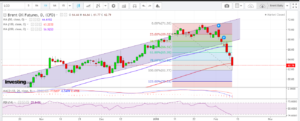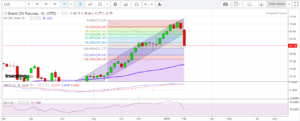Crude Oil
Oil prices finished lower for a sixth straight session on Friday to tally their worst weekly loss in two years, as investors continued to fret over soaring U.S. output levels. Brent crude futures tumbled $ 2.02 to settle at $ 62.79 /bbl. WTI also sank $ 1.90 cents to close at $59.20 /bbl.
For the week, WTI crude lost roughly 9.6%, which was the biggest such decline since January 2016, while Brent gave up about 8.5%. It is perhaps relevant to add that these losses have been through high volume trading sessions which reflect the strength of the fall.
US production which scaled 10 million barrels per day rather dramatically last week. This is higher than that of Saudi Arabia and within reach of Russia’s output levels.
The number of oil drilling rigs shot up by 26 to 791 last week, as reported by the energy services firm Baker Hughes. This is the highest level since April 2015. It also marked a third straight week of increases and the largest weekly rise in more than a year, implying that further gains in domestic production are ahead.
Oil prices have also been hit by steep losses in the global stock market and a strengthening of the US dollar.
In other news, the US is poised to sell some 100m barrels of oil from its SPR by 2027, as outlined by the spending deal which has passed both houses of Congress. This would mean a 45% decrease in the volume in the SPR to about 303 million barrels.
Not surprisingly, speculators continued to cut their near-record length in crude – WTI and Brent futures and options together saw a net reduction of 25,000 lots. Still, the group held more than 1 million contracts in WTI and Brent as of last Tuesday, implying that further reductions are in the cards if the macro money continues its exit.
Technical Analysis


Tradeable Trend Over
Crude Prices crashed last week, breaking through many technical supports on the way down. Last week’s close was taking a soft support on the six month rising trendline. We had also warned of an imminent breakdown in the structure in our OPD of 6th February.
The week under review sees this demand line overwhelmed with a long bearish trend action. So swift is the action that the trend not only breaks down, but it also breaks back into the six week consolidation zone of November – December 2017 where prices were consolidating between $ 60.50 – $ 64.50. You may remember that the break out from this zone was the basis for calling fresh upside momentum.
However, this break out is just one day old and it would be prudent to wait for a few days to confirm.
Trading Strategy
The strategy for this week would be to sell either on a fresh break down or a pull back to resistance levels. The immediate target would be $ 58.50, a swing high achieved almost a year ago. A multi-year channel support comes in at around $ 53.00 this month. Since this would change every month, we will look at $ 58.50 for now.
Supports and Resistances
Immediate supports would lie in the $ 61.70 – $ 62.00 range (last week’s close) and then $ 59.50 levels below. Resistances would like in at $ 63.70-80 and then $ 65.40-50 with the 50 DMA as a third level at $ 66.60. These could be used as levels to initiate fresh shorts.
Naphtha
Building on its gains last Thursday, the physical Asian naphtha crack managed to climb further on Friday to settle at $ 70.75 /MT. With market fundamentals still weak, several buyers were seen emerging in the spot market to capitalize on high supplies and low prices.
The balance February paper naphtha crack has managed to climb back up into positive territory being valued at $ 0.22 /bbl today with the March crack at $ 0.35 /bbl
Gasoline
The physical Asian gasoline crack also rose on Friday settling at $ 9.00 /bbl. However, this improvement in margin is attributable more to the sharp fall in crude prices as opposed to strengthening demand. Weekly inventories across key trading hubs viz U.S., Amsterdam-Rotterdam-Antwerp (ARA), Fujairah and Singapore were all up last week pointing to adequate supply.
In the Platts Asian Trading Window, Hin Leong continued its buying spree snapping up three out of the four gasoline deals that were concluded.
The balance February paper 92 Ron gasoline crack is valued higher at $ 12.25 /bbl with March valued at $ 12.80 /bbl
Distillates
Weakening demand in the physical spot market have caused the distillate cracks to be valued lower today. Although Singapore weekly inventories were down last week, inventories in the other two key hubs viz U.S and Amsterdam-Rotterdam-Antwerp (ARA) showed strong build thereby putting a cap on prices.
The balance February paper gasoil crack is lower at $ 13.90 /bbl. The 10 ppm crack is at $ 14.60 /bbl. The February regrade has come off and is valued at $ 1.20 /bbl today.
The March paper gasoil crack is at $ 14.00 /bbl. The 10 ppm crack is at $ 14.70 /bbl. The March regrade is valued at $ 0.55 /bbl today.
Hedging recommendations made earlier are being retained (until they are squared off). Current values are juxtaposed in (Red)
Cal 2019: Gasoil 500 ppm $ 16.10 /bbl (14.70): Gasoil 10 ppm $ 17.45 /bbl (15.65): Jet $ 16.85 /bbl (15.40)
We will now close this trade off as well having made over $ 1 /bbl. For hedgers, we do not seriously recommend closing the position. As far as we are concerned, we were just showing the position to show the results of our call. As soon as a position is well in the money, we would stop tracking it.
Fuel Oil
The recent sharp fall in crude prices has helped prop up the fuel oil cracks which is valued higher this morning. However, an absence of buying interest for 380-cst fuel oil cargoes in the Singapore Platts trading window resulted in cash premiums slipping for a fourth consecutive day on Friday to $ 0.17 /MT, down from a $ 1.12 /MT on Monday
The February 180 cst crack is valued higher at -$ 3.90 /bbl. The visco spread is unchanged at $ 0.85 / bbl. The March 180 cst crack is valued at -$ 3.65 /bbl. The visco spread is at $ 0.95 / bbl.
About this blog
This blog post attempts to give a top level summary of the Singapore market goings on to a person who seeks to obtain a directional sense of the market on a daily basis.
Disclaimer : All the views are the author’s personal views. These do not constitute an advice to buy or sell any commodity
